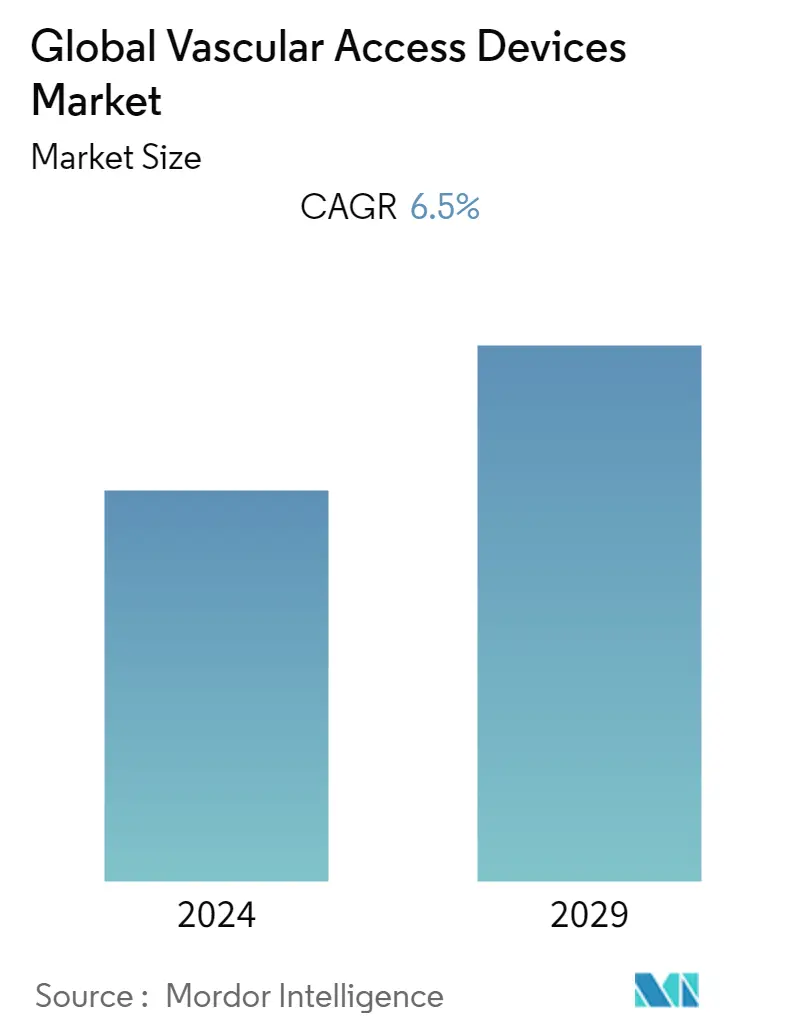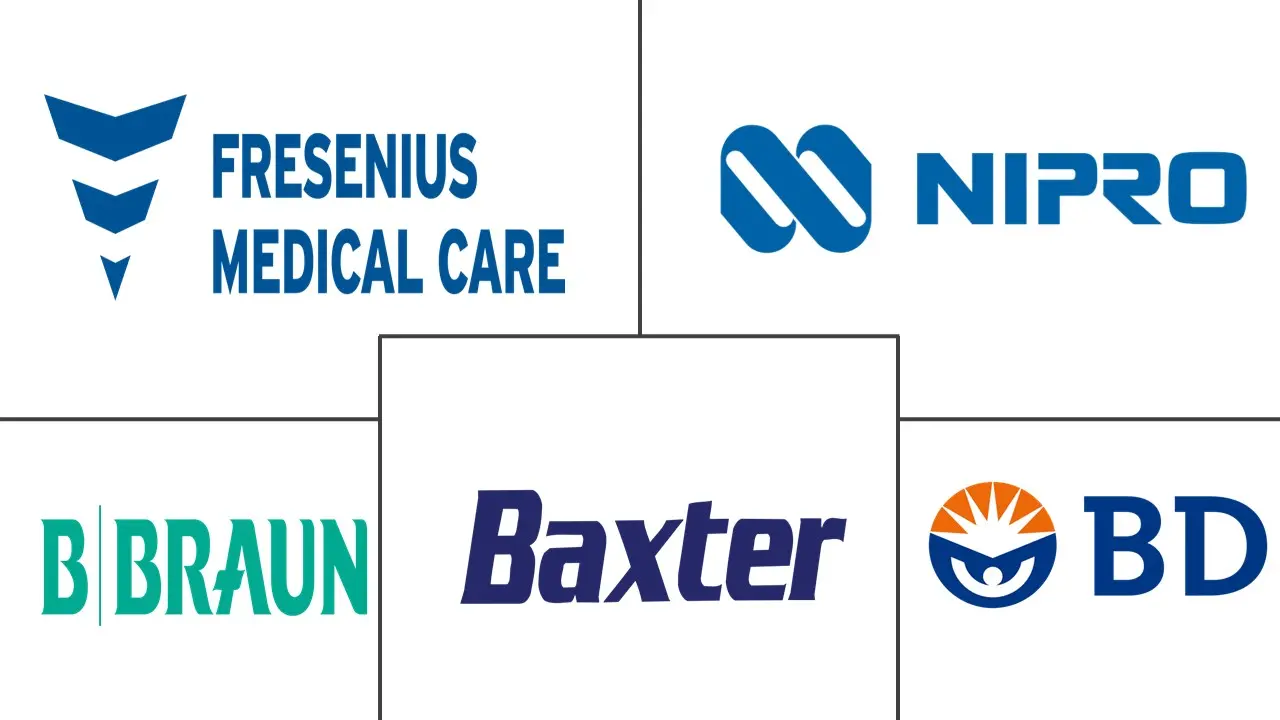Market Size of Global Vascular Access Devices Industry

| Study Period | 2019 - 2029 |
| Base Year For Estimation | 2023 |
| CAGR | 6.50 % |
| Fastest Growing Market | Asia-Pacific |
| Largest Market | North America |
| Market Concentration | Low |
Major Players
*Disclaimer: Major Players sorted in no particular order |
Vascular Access Devices Market Analysis
The global vascular access devices market is expected to register a CAGR of nearly 6.5% during the forecast period (2022-2027).
The demand for medical equipment has been impacted by COVID-19 in numerous ways. While the demand for the devices used to treat COVID-19 patients in intensive care has increased, other devices have suffered as a result of delayed or canceled treatments. According to the study titled 'The impact of the COVID-19 pandemic on vascular surgery: Health care systems, economic, and clinical implications' published in the National Library of Medicine in July 2021, in ambulatory care and outpatient clinics, 89.2% of vascular surgeons reported changes to their practice, including fewer hours (71%) and the use of telehealth services (81.1%). Clinical volume dropped by 96.5%, surgical volume dropped by 71.7%, and the daily number of inpatient consultations dropped to just 1.81 per day. Thus, the decline in surgical volume significantly hampers the market during COVID-19. Moreover, according to the study titled "Patterns of vascular access device use and thrombosis outcomes in patients with COVID-19: a pilot multi-site study of Michigan hospitals" published in May 2022, patients who have the 2019 coronavirus disease (COVID-19) are at a high risk of venous thromboembolism (VTE). 10.0% of COVID-19 hospitalized patients in Michigan who had vascular access devices had a VTE incident, compared to 4.3% of those without these devices. Thus, vascular access devices increased the risk of VTE in COVID-19 patients hence it has hampered the market growth during the COVID-19 pandemic.
Over the past decade, there has been a rise in the prevalence of several chronic diseases that need vascular access treatment. Some of the major chronic diseases include cancer, kidney failure, and heart diseases, among others. Along with these, there are several lifestyle disorders relating to chronic and non-communicable disease conditions, such as hypertension, diabetes, obesity, and depression, among others, which need critical care during their hospitalization. According to GLOBOCAN 2020, the new cancer cases that were diagnosed accounted for 19,292,789 in 2020 globally, with 9,958,133 deaths due to cancer. Moreover, as per the same source, among all cancers, breast cancer accounted for 2,261,419 new cancer cases, followed by lung cancer with 2,206,771 new cases, prostate cancer with 1,414,259, and colon cancer with 1,148,515 new cases in 2020. Additionally, according to World Health Organization (WHO) data published in April 2021, chronic diseases are expected to kill 41 million people each year, equivalent to 71% of all deaths globally. Also, 77% of mortality in low- and middle-income nations is attributable to chronic diseases. Additionally, as per the same source, most of the chronic illness mortality, or around 17.9 million people per year, is caused by cardiovascular disorders, followed by cancers (9.3 million), respiratory diseases (4.1 million), and diabetes (1.5 million). With the increase in the number of cancer cases, the demand for vascular access devices is expected to increase over the forecast period.
The vascular access devices demand is growing in pediatrics for several indications. For instance, according to the study titled "Pediatric central venous access devices: practice, performance, and costs" published in the pediatric Research in February 2022, the majority of pediatric health disciplines employ central venous access devices (CVADs) as a standard tool for a variety of therapies, including lifelong parenteral feeding for gut enteropathies and the delivery of antibiotics for persistent osteomyelitis. Thus, increasing use of the vascular access devices in the pediatric discipline is anticipated to boost the market growth over the forecast period.
With the rising prevalence of chronic diseases and lifestyle disorders, vascular access procedures are increasingly being used for intravenous antibiotic treatment, long intravenous nutritional support, and drawing of blood samples. Hence this is expected to draw the attention of several multinational medical devices companies to invest and launch new products, thus, acting as one of the major drivers for this market. For instance, in June 2021, medK launched a needle-free solution for vascular access. The needle-free connection tends to offer access to the fluid lines, thereby reducing the risk of needle sticks. Additionally, in May 2022, Shockwave Medical announced the global commercial availability of the Shockwave M5+ peripheral intravascular lithotripsy (IVL) catheter after receiving both CE mark and the United States Food and Drug Administration (FDA) clearance.
However, stringent regulation and product recall, and risks associated with catheter usage restraint the market growth over the forecast period.
Vascular Access Devices Industry Segmentation
As per the scope of the report, vascular access devices (VADs) are inserted into the veins for diagnostic and therapeutic reasons, such as blood sampling, central venous pressure readings, administration of medication, fluids, total parenteral nutrition (TPN), and blood transfusions. These are inserted peripherally or centrally. The choice of device for each patient differs and multiple types of devices may be required at a time, as a single device may not be able to meet all the requirements. The Vascular Access Devices Market is segmented by Device Type (Central Vascular Access Devices (Peripherally Inserted, Central Catheters, Percutaneous Non-tunneled Catheters, Other Central Vascular Access Devices) and Peripheral Vascular Access Devices (Peripheral Catheter, Midline Catheter, Other Peripheral Vascular Access Devices), Application (Administration of Drugs Administration of Fluid and Nutrition, Diagnostics and Testing, Other Applications) End-User (Hospital/Clinic, Diagnostic Centers, Other End Users), and Geography (North America, Europe, Asia-Pacific, Middle East and Africa and South America). The market report also covers the estimated market sizes and trends for 17 different countries across major regions, globally. The report offers the value (in USD million) for the above segments.
| By Device Type | |||||
| |||||
|
| By Application | |
| Administration of Drugs | |
| Administration of Fluid and Nutrition | |
| Diagnotics and Testing | |
| Other Applications |
| By End User | |
| Hospital/Clinic | |
| Diagnostic Centers | |
| Other End Users |
| Geography | ||||||||
| ||||||||
| ||||||||
| ||||||||
| ||||||||
|
Global Vascular Access Devices Market Size Summary
The vascular access device market is poised for significant growth, driven by the increasing prevalence of chronic diseases such as cancer, kidney failure, and cardiovascular disorders. These conditions necessitate the use of vascular access devices for treatments like intravenous antibiotic administration and long-term nutritional support. The market is also witnessing a rise in demand within the pediatric sector, where central venous access devices are standard for various therapies. Despite the challenges posed by the COVID-19 pandemic, which temporarily disrupted surgical volumes and increased risks associated with vascular access devices, the market is expected to recover and expand. The introduction of innovative products, such as needle-free solutions and advanced catheters, further supports this growth trajectory.
North America is anticipated to hold the largest market share, attributed to the high incidence of cardiovascular diseases and cancer, alongside robust research and clinical trials in the region. The market's competitive landscape features major players like B. Braun Melsungen AG, Baxter International Inc., and Fresenius Medical Care, who are actively launching new products and leveraging strategic acquisitions to enhance their portfolios. Regulatory support and advancements in healthcare infrastructure are also contributing to market expansion. As technological innovations continue to emerge, the vascular access device market is expected to experience sustained growth, driven by the increasing demand for effective and safe medical solutions.
Global Vascular Access Devices Market Size - Table of Contents
-
1. MARKET DYNAMICS
-
1.1 Market Overview
-
1.2 Market Drivers
-
1.2.1 Increasing Prevalence of Lifestyle-related Disorders
-
1.2.2 Increasing Number of Chemotherapy Procedures with High Hospitalization Rates
-
1.2.3 Rising Use of Vascular Access Devices among Paediatric Patients
-
-
1.3 Market Restraints
-
1.3.1 Risks Associated with Catheter Usage
-
1.3.2 Stringent Regulations and Product Recalls
-
-
1.4 Porter's Five Force Analysis
-
1.4.1 Threat of New Entrants
-
1.4.2 Bargaining Power of Buyers/Consumers
-
1.4.3 Bargaining Power of Suppliers
-
1.4.4 Threat of Substitute Products
-
1.4.5 Intensity of Competitive Rivalry
-
-
-
2. MARKET SEGMENTATION (Market Size by Value - USD Million)
-
2.1 By Device Type
-
2.1.1 Central Vascular Access Devices
-
2.1.1.1 Peripherally Inserted Central Catheters
-
2.1.1.2 Percutaneous Non-tunneled Catheters
-
2.1.1.3 Other Central Vascular Access Devices
-
-
2.1.2 Peripheral Vascular Access Devices
-
2.1.2.1 Peripheral Catheter
-
2.1.2.2 Midline Catheter
-
2.1.2.3 Other Peripheral Vascular Access Devices
-
-
-
2.2 By Application
-
2.2.1 Administration of Drugs
-
2.2.2 Administration of Fluid and Nutrition
-
2.2.3 Diagnotics and Testing
-
2.2.4 Other Applications
-
-
2.3 By End User
-
2.3.1 Hospital/Clinic
-
2.3.2 Diagnostic Centers
-
2.3.3 Other End Users
-
-
2.4 Geography
-
2.4.1 North America
-
2.4.1.1 United States
-
2.4.1.2 Canada
-
2.4.1.3 Mexico
-
-
2.4.2 Europe
-
2.4.2.1 Germany
-
2.4.2.2 United Kingdom
-
2.4.2.3 France
-
2.4.2.4 Italy
-
2.4.2.5 Spain
-
2.4.2.6 Rest of Europe
-
-
2.4.3 Asia-Pacific
-
2.4.3.1 China
-
2.4.3.2 Japan
-
2.4.3.3 India
-
2.4.3.4 Australia
-
2.4.3.5 South Korea
-
2.4.3.6 Rest of Asia-Pacific
-
-
2.4.4 Middle-East and Africa
-
2.4.4.1 GCC
-
2.4.4.2 South Africa
-
2.4.4.3 Rest of Middle-East and Africa
-
-
2.4.5 South America
-
2.4.5.1 Brazil
-
2.4.5.2 Argentina
-
2.4.5.3 Rest of South America
-
-
-
Global Vascular Access Devices Market Size FAQs
What is the current Global Vascular Access Devices Market size?
The Global Vascular Access Devices Market is projected to register a CAGR of 6.5% during the forecast period (2024-2029)
Who are the key players in Global Vascular Access Devices Market?
NIPRO Medical Corporation, Fresenius Medical Care, B. Braun Melsungen AG, Baxter International Inc. and Becton, Dickinson and Company are the major companies operating in the Global Vascular Access Devices Market.

